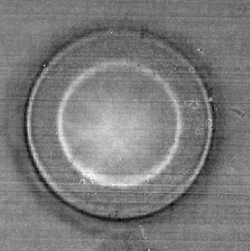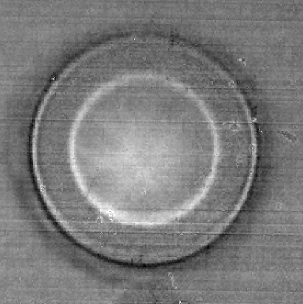Thermal Explosions on Film
Some explosions begin with a bang, and some begin with a whimper. Unlike the triggered explosions used in mining or bombs, a thermal explosion occurs at an unpredictable time, after an explosive is heated gradually–as in a munitions factory fire. In the 6 June Physical Review Letters, a research team reports on the first direct, real-time look at how a thermal explosion unfolds and releases its energy. The team synchronized the explosion with pulses from a proton accelerator and made a high-speed movie of the blast. They hope their new technique will result in more accurate modeling and safer explosives.
Armies and miners use so-called supersonic explosions, which involve a shock wave propagating through the explosive, and which are detonated at a precise time by a trigger. In contrast, thermal explosions most often occur in accidents such as factory fires, where an explosive is exposed to heat, and the time of explosion is unpredictable. All explosives contain the raw material for some heat-releasing chemical reaction, but in advance of a thermal explosion, the reaction begins slowly, triggered by the heat source. As the reaction proceeds, it further heats the material and increases the reaction rate. Eventually the feedback leads to a “run-away” reaction that we call an explosion. The same material can explode either thermally or supersonically, depending on conditions, but the internal dynamics are different.
Researchers have made high-speed movies of supersonic explosions with beams of x-rays or protons, but synchronizing a thermal explosion to an imaging technique has, until now, been impossible. And without a way to look inside, researchers have been unable to nail down the fundamental processes at work inside the blast–such as the speed and direction of heat flow.
Laura Smilowitz and her colleagues at the Los Alamos National Laboratory in New Mexico were able to control a thermal explosion by using a precisely timed laser pulse. First they slowly heated an aluminum-encased, 25-millimeter-long cylinder of the high explosive HMX, while monitoring the temperature for thermal runaway. When the rate of temperature increase reached a certain value, they heated the center of the material by pulsing a laser through an optical fiber embedded along the cylinder’s axis, triggering the explosion. “The laser is tickling the temperature at the very end,” Smilowitz says. The signal that set off the laser also triggered a pulse train from their proton beam aimed at the cylinder. The team detected protons passing through the exploding material to make images, much like a series of x rays spaced by roughly ten microseconds.
The movies show the HMX beginning to form a network of cracks immediately after the laser trigger, as the cylinder pressurizes inside its metal casing. The chemical reaction forms a hot gas that carries heat outwards and ignites some of the material in its wake. Once ignited, more heat is transmitted through thermal conduction, which leads to further burning and consumption of any remaining fuel. Most aspects of the explosion agreed with researchers’ suspicions based on simulations and less direct experiments, but the results confirmed those ideas and provided details such as the pressures involved and the speed of heat propagation.
Smilowitz and her colleagues hope their experimental technique and further improved simulations will help researchers better understand thermal explosions, possibly leading to safer designs and better safety procedures. Craig Tarver, of the Lawrence Livermore National Laboratory in California, thinks the technique will be important for understanding thermal explosions and accident scenarios. “Knowing where in the explosive charge the explosion begins, how fast the subsequent reaction propagates, and when and where the confining material begins to fragment is crucial for predicting the damage to the surroundings,” he says.
–Michelangelo D'Agostino
Michelangelo D’Agostino is a physicist and freelance science writer in Berkeley, California.





